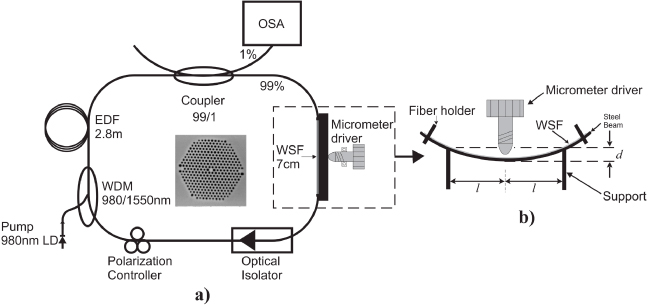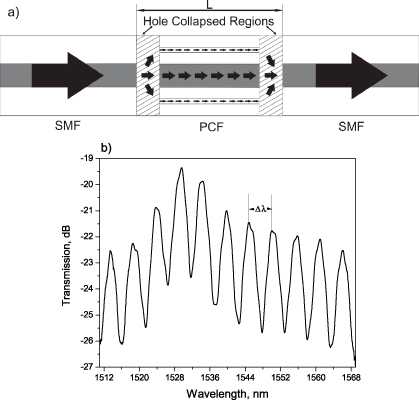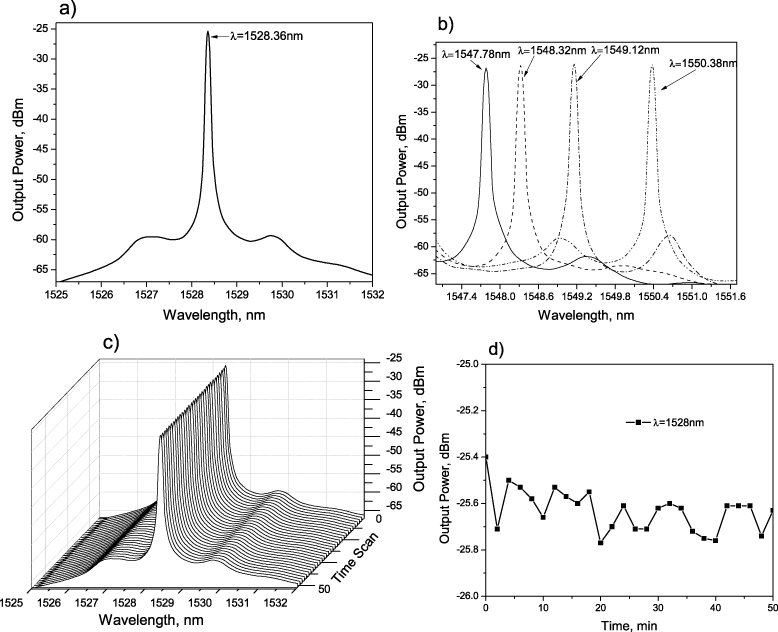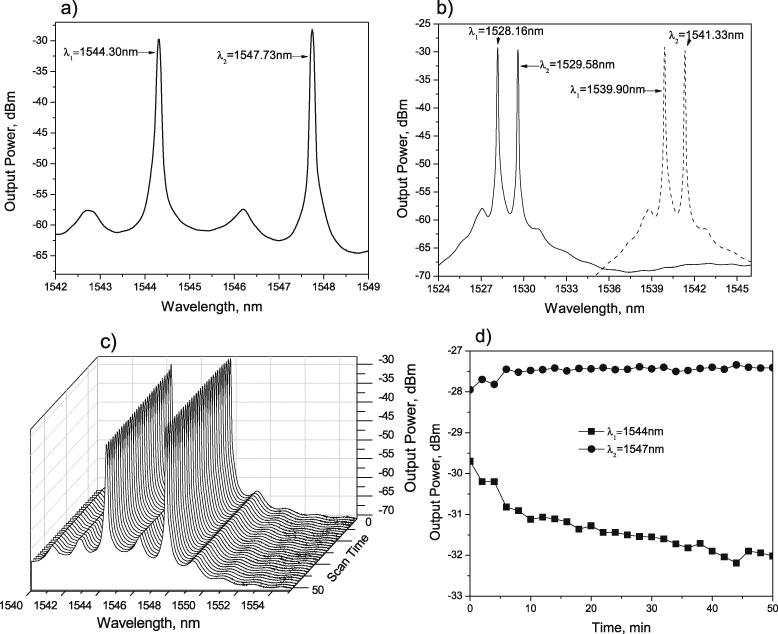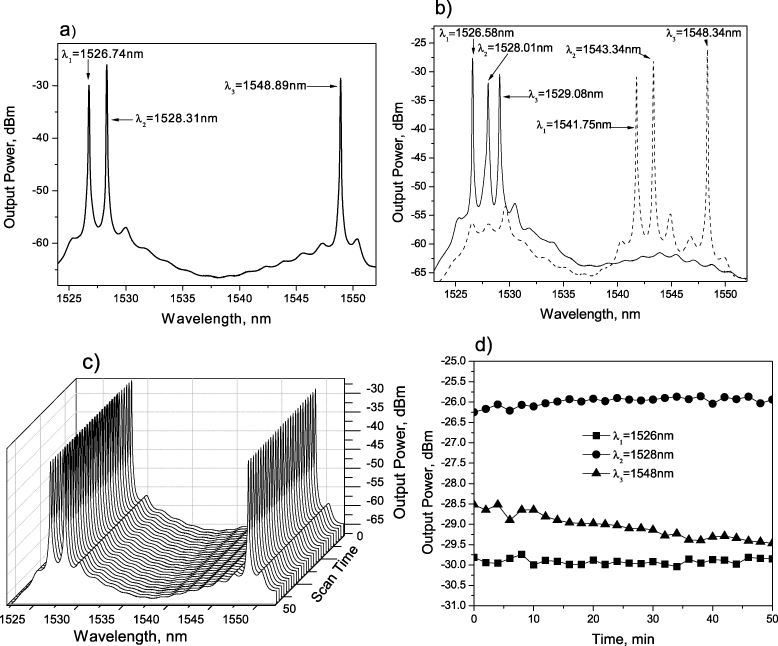Abstract
In this paper a tunable multi-wavelength erbium doped fiber laser, based on a Mach–Zehnder interferometer, is presented. The interferometer is achieved by splicing a piece of photonic crystal fiber between two segments of a single-mode fiber. Here, by changing the curvature radius in the Mach–Zehnder interferometer, the single-, double- or triple-line emissions can be tuned from 1526 to 1550 nm. Finally it is shown, via experimental results, that the laser has high stability at room temperature.
Export citation and abstract BibTeX RIS
1. Introduction
In recent years multi-wavelength erbium doped fiber lasers (MW-EDFLs) have been intensively studied since they can be applied in several fields such as sensing, optical processing, wavelength division multiplexing for communication systems and spectroscopy [1–5]. Some MW-EDFLs are based on wavelength-selective filters (WSFs) which balance wavelength dependent cavity losses [6–17]. Currently WSFs can be implemented in different ways such as through fiber Bragg gratings [7, 8], Fabry–Perot interferometers [9, 10], Sagnac interferometers [11, 12], acoustic optical filters [13] and Mach–Zehnder interferometers (MZIs) [14, 17]. For instance, tunable MW-EDFLs based on MZIs with tuning range from 1530 to 1560 nm have been reported in [15, 16], with each MZI formed by splicing a photonic crystal fiber (PCF) between two segments of single-mode fiber (SMF). Another example of a MW-EDFL using an MZI was presented by Zhang et al [17], where the authors achieved a laser emission with a tuning range of 20 nm and power fluctuations ≤0.5 dB. Recently some MW-EDFLs based on bending effects over the WSF have been presented [18–21]. For instance, Shi [18] implemented a laser which can be continuously tuned from 1573 to 1595 nm with a side mode suppression ratio (SMSR) of 50 dB within the total tuning range. Another tunable MW-EDFL based on a fiber bending scheme was proposed in [19], in which the laser lines were tuned from 1526 to 1538 nm and from 1568 to 1557 nm with a maximum separation between laser lines of 42 nm. A further example of a MW-EDFL is the self-seeded tunable laser proposed by [20], where the laser was able to achieve tuning ranges of 20 and 10 nm for single- and dual-wavelength lasing respectively, while for triple- and quadruple-wavelength lasing the tuning range was 7 and 3 nm respectively. In addition, a triple-wavelength switchable multi-wavelength EDFL has also been reported in [21]; that laser was based on a highly nonlinear photonic crystal fiber which was bent in order to tune the laser lines.
In this paper a tunable MW-EDFL based on a WSF is presented. Here the WSF is a MZI formed by splicing a piece of PCF between two segments of a single-mode fiber forming a SMF–PCF–SMF structure. This laser is able to emit a single, double or triple wavelength and it can be tuned by modifying the curvature radius of the MZI. Furthermore, the tuning range achieved was from 1526 to 1550 nm with a SMSR of ∼30 dB. Finally, via experimental results it is shown that our MW-EDFL presents high stability at room temperature.
2. The experimental setup
The experimental setup of the proposed cavity ring MW-EDFL is presented in figure 1(a). Here as gain medium an EDF segment of 2.8 m length (Thorlabs, model M5-980-125), with a dopant concentration of 300 ppm and small signal absorption of 11.5 dB m−1, was used. As a pump source a 977 nm laser diode with 150 mW maximum output power (QPhotonics, model QFBGLD-980-150J) was used. This was coupled into the ring cavity by the 980/1550 nm wavelength division multiplexer (WDM). Moreover, the optical isolator ensured unidirectional light propagation. The polarization state was adjusted with the polarization controller (PC) and the laser output was obtained from the 1% port of the 99/1 fiber coupler. The 99% port output provided the laser cavity feedback, for maintaining the laser oscillation. The laser output was monitored with an optical spectrum analyzer (Yokogawa, model AQ6370B) with a resolution of 0.02 nm. Finally, the WSF was fixed over a steel strip, which was laid over two supports, and was bent by using a micrometer screw (figure 1(b)).
Figure 1. (a) Experimental setup of the tunable multi-wavelength erbium doped fiber laser and (b) schematic diagram of the mechanism used to change the bending radius.
Download figure:
Standard image High-resolution imageIt is important to point out that in our experiment we used a 99/1 fiber coupler in order to have as high a laser cavity feedback as possible since the WSF implemented for this work presented high insertion losses. Moreover, a single-line emission was generated by taking advantage of the nonlinear wavelength dependent polarization effects, which can be controlled by using the PC [21]. In this way when a single-line emission was reached the PC remained fixed, while the tuning process and the switching of the dual- and triple-line emissions were carried out by bending the WSF. It is important to recall that the WSF curvature is given by C = 1/R = 2d/(d2 + l2), where R is the curvature radius, d is the displacement measured at the strip center and l is half the distance between the two supports (figure 1(b)) [22].
3. MZI fabrication and the principle of operation
The MZI was fabricated with a piece of PCF and two segments of SMF which were spliced by using a standard electrical discharger splicer (Fitel S175). For our experimental setup we utilized 7 cm of PCF, model NL-PM-750 from Crystal Fiber A/S, which has a core diameter of 1.5 μm, an air hole diameter of 2.36 μm and hole-to-hole spacing of 0.56 μm (see the inset of figure 1(a)). Moreover, the fiber splicer was programmed with the following parameters: 91 mW of arc power, 240 ms of pre-fusion time and 850 ms of arc duration. Here, at both sides of the PCF hole collapsed points are induced by the electrical discharges.
In this MZI interferometer the collapsed points act as fiber couplers while the PCF core and cladding act as the interferometer arms (figure 2(a)). Here the fundamental mode was partly coupled into some cladding modes at the first collapsed point. At the end of the PCF the core and cladding modes will present a phase difference since these travel by the MZI arms which have different effective refractive indices. Afterwards these modes are recoupled at the second collapsed point. The transmission spectrum of the MZI implemented is shown in figure 2(b). The insertion loss of the filter was around 18 dB. In addition, considering the MZI as a two-mode interferometer, it is therefore possible to state that the spectral separation between two consecutive peaks is given by

where Δne is the effective refractive index difference between the PCF's core and cladding, λ represents the wavelength and L is the length of the PCF segment (figure 2(a)) [15]. Here it is possible to tune the MZI fringe pattern or change its spectral separation by varying the parameters of equation (1). This can be taken advantage of to tune the laser emissions. In our setup arrangement (figure 1(a)) a change in the material density will be observed as curvature is applied over the MZI. This consequently will induce a change in the effective refractive index (Δne) [23]. Moreover a small cavity length change in the MZI will occur as the curvature is varied. All these changes will cause a variation of the output spectrum [24]. Therefore, the overall laser output characteristics such as the number of lines emitted, their position and its tuning range will strongly depend on the PCF optical properties, the polarization state, the bending curvature and the SMF–PCF–SMF structure characteristics.
Figure 2. (a) Schematic diagram of the Mach–Zehnder interferometer and (b) transmission spectrum of the Mach–Zehnder interferometer.
Download figure:
Standard image High-resolution image4. Experimental results and discussion
In order to carry out our experiments the laser diode was set at 120 mW, which was the saturation pump power of the EDF. Moreover as the emission laser lines directly depend on the spectral transmission peaks produced by the MZI it was necessary to shift the spectral pattern to tune the laser at different wavelengths. In our case the spectral shifting was performed by adjusting the curvature radius while the PC was fixed at a certain position. Hence the curvature radius was varied until the homogeneous linewidth of the EDF was reduced enough to obtain single-laser emission. In this case when C = 0.771 69 m−1 a laser emission centered at λ = 1528.36 nm was obtained (figure 3(a)). Moreover, when the curvature radius was changed from 0.771 73 to 0.766 29 m−1, the single-laser emission was tuned from 1526 to 1550 nm with a SMSR of 30 dB (figure 3(b)). It is important to point out that after the curvature radius is increased over a certain point the laser line is tuned abruptly to longer wavelengths. To validate the power stability operation of the laser at room temperature, its spectrum was scanned repeatedly for 50 min at intervals of 2 min (figure 3(c)). From these results it can be observed that the output power variations were ≤0.2 dB (figure 3(d)).
Figure 3. (a) Single-laser output spectrum, (b) tuning of one of the laser emissions, (c) measured output spectrum recorded every 2 min and (d) laser output power variations.
Download figure:
Standard image High-resolution imageThe dual-wavelength laser was obtained by changing the curvature radius of the MZI to C = 0.766 57 m−1 (figure 4(a)). For this case, the spectral separation between the two emitted lines could be varied by finely adjusting the mechanical micrometer (figure 4(b)). For this case it is important to comment that during the tuning process there is a certain point where the two lines overlap, producing single-line emission. As in the single-line case, the laser spectrum was recorded every 2 min for 50 min (figure 4(c)) to determine its stability over time. In this way it was measured, for the particular case where the laser emitted simultaneously at 1544.30 and 1547.73 nm, that the fluctuation output powers were ≤2 and ≤0.2 dB respectively and the SMSR was 30 dB for both lines (figure 4(d)).
Figure 4. (a) Dual-laser output spectrum, (b) tuning of one of the laser emissions, (c) measured output spectrum recorded every 2 min and (d) laser output power variations.
Download figure:
Standard image High-resolution imageTo obtain a triple-line laser the curvature radius was finely adjusted until the three emission lines were obtained. For instance, figure 5(a) shows measured emission lines at 1526.73, 1528.31 and 1548.89 nm for a curvature radius of C = 0.776 969 m−1. Moreover, the spectral separation between these lines can be varied. Hence, to give an example, we spectrally tuned the 1531 nm line, as is shown in figure 5(b). It is important to mention that in certain cases some of these lines match in position the lines obtained in the single- and double-laser operation modes. The laser emissions, for the particular case where the emission was at 1526.74, 1528.31 and 1548.89 nm, were recorded every 2 min for 50 min to determine the stability (figure 5(c)). For these lines, the measured SMSRs were 25, 28 and 30 dB and the output power variations were ≤0.5, ≤ 0.5 and ≤1 dB respectively (figure 5(d)). In general, for all three emission cases the measured laser wavelength shift was ≤0.05 nm, considering 50 min of continued operation at room temperature. These measurements were performed at different times of the day and the laser emission was practically constant.
Figure 5. (a) Triple-laser output spectrum, (b) tuning of one of the laser emissions, (c) measured output spectrum recorded every 2 min and (d) laser output power variations.
Download figure:
Standard image High-resolution image5. Conclusions
A stable tunable multi-wavelength erbium doped fiber laser, operating at room temperature, was achieved by exploiting Mach–Zehnder interferometer (MZI) modal interference. The MZI was used as a wavelength-selective filter and it was implemented by splicing a piece of PCF between two segments of SMF. It was shown that the laser proposed here can be set to emit single, dual or triple wavelengths. Furthermore it was observed that the tunable wavelength characteristics strongly depend on bending losses which induce coupling of the fundamental mode to a high-order mode. These losses can be modified by changing the curvature radius. From experimental measurements it was determined that the tunable spectral range was 26 nm (from 1526 to 1550 nm) and all laser emissions presented low spectral shifting (≤0.05 nm) during 50 min of continued operation. Finally this tunable laser can be used potentially in different applications such as optical sensing and communications systems, since it is easy to tune and cost effective.
Acknowledgments
J M Sierra-Hernandez is grateful to CONACYT for the research grant No. 175106/175106. This work was partially funded by FOMIX CONACYT—Gobierno del Estado de Guanajuato (project GTO-2012-C02-187434), CONACYT (project 183893) and SEP-Universidad de Guanajuato through PIFI 2012.


